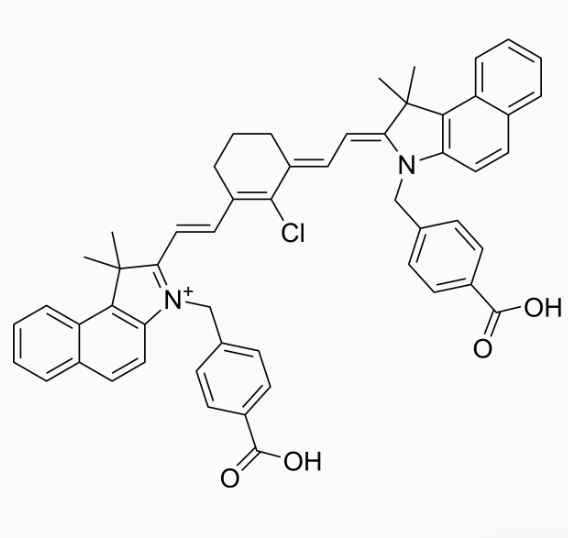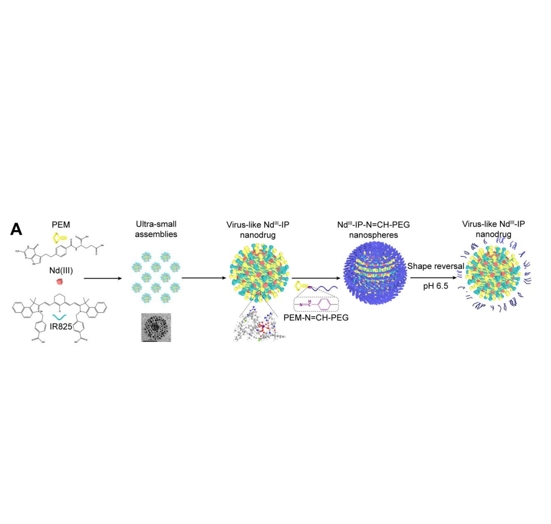文献:Tumor Microenvironment-Responsive Shape-Reversal Self-Targeting Virus-Inspired Nanodrug for Imaging-Guided Near-Infrared-II Photothermal-Chemotherapy
文献链接:https://pubs.acs.org/doi/abs/10.1021/acsnano.9b05425
作者:Yang Li, Jinyan Lin, Peiyuan Wang, Qiang Luo, Huirong Lin,Yun Zhang, Zhenqing Hou, Jingfeng Liu, and Xiaolong Liu
相关产品:IR825
原文摘要:
Tumor microenvironment-responsive multi-modal synergistic theranostic strategies can significantly improve the therapeutic efficacy while avoiding severe side effects. Inspired by the fact that special morphology could enhance photothermal conversion efficiency (PCE) and cellular delivery, we developed an acidic tumor microenvironment-responsive shape-reversal metal-organic virus-inspired nanodrug for enhancing near-infrared (NIR)-II PCE,increasing cell adhesion, and activating tumor targeting. Firstly, NIR-I fluorescence probe (IR825), chemo-drug (pemetrexed, PEM), rare-earth metal ion (Nd(III)), were chosen to synthesize virus-like nanodrug via coordination-driven assembly. Then, the spike-like surface of nanodrug was further camouflaged by acidity-sensitive PEG “shell” to create virus-cored and sphere-shelled hierarchical nano-assemblies, which could efficiently prevent immune clearance and prolong systemic circulation. Interestingly, the acidic tumor microenvironment could trigger the shell detachment of nano-assemblies for shape reversal to produce virus-like surface followed by re-exposure of PEM, to synergistically amplify the cellular internalization while enhancing NIR-II PCE. By utilizing the shell-detached virus-like nanodrug core, the tumor microenvironment-specific enhanced NIR-II photothermal-chemotherapy can be realized under the precise guidance of fluorescence/photoacoustic imaging, thereby achieving complete tumor elimination without recurrence in a single treatment cycle. We envision that integrating tumor microenvironment-responsive ability with “sphere-to-virus”shape reversal will provide a promising strategy for biomimetic targeted cancer therapy.
IR825,属于吲哚菁绿类近红外荧光染料。这种染料具有良好的光学性能,在近红外光区(700 - 900nm)有较强的荧光发射。由于生物组织在近红外波段自身荧光较弱,因此在此波段的荧光染料可以获得较高的成像对比度。IR825 的荧光特性使其可以用于标记生物分子,如蛋白质、核酸等,用于细胞成像和活体成像研究。它还具有较好的光稳定性,在长时间的光照下,其荧光强度不会快速衰减,这对于长时间的成像观察是非常有利的。

图:IR825结构式
若纳米化合物表面的活性基团需要活化:将纳米化合物悬浮液置于反应容器中,在磁力搅拌下,加入适量的 EDC 和 NHS,用量通常根据纳米化合物表面活性基团的数量估算。反应温度保持在室温,使纳米化合物表面的羧基等活性基团被活化,形成更具反应活性的中间体。
物理吸附法标记:将纳米化合物悬浮液和 IR825 溶液按照一定的比例混合。比例的确定要考虑纳米化合物的比表面积、IR825 的吸附能力等因素。然后将混合溶液置于超声仪中超声处理,使 IR825 更好地吸附在纳米化合物表面。超声结束后,将反应体系转移至磁力搅拌器上,在室温下搅拌,使吸附达到平衡状态。
化学键合法标记:当纳米化合物表面有活性基团(如氨基),IR825 有相应的反应基团(如羧基)时,可通过形成化学键进行标记。在磁力搅拌下将纳米化合物悬浮液置于反应容器中,缓慢加入 IR825 溶液,同时加入适量的 EDC 作为缩合剂。IR825 溶液的加入量要根据纳米化合物表面活性基团的数量和期望的标记密度来确定。控制反应温度及反应时间。在这个过程中,纳米化合物表面的氨基与 IR825 的羧基在 EDC 的作用下,通过形成酰胺键将 IR825 连接到纳米化合物上。

图:合成示意
结论:
该文献成功用IR825 标记了NdIII-IP virus-like nanodrugs。标记后该纳米化合物可以通过近红外荧光成像技术在生物体内进行追踪,观察纳米化合物在体内的分布情况,追踪纳米化合物在体内循环中的路径,了解其在不同器官和组织中的富集程度。纳米化合物在目标部位的化合物释放是化合物Treatment 的关键环节。IR825 标记可以用于间接监测化合物释放过程。当纳米化合物释放化合物时,其内部结构、表面性质等可能会发生变化,这些变化可能会影响 IR825 的荧光信号。

 2025-02-11 作者:ws 来源:
2025-02-11 作者:ws 来源:

